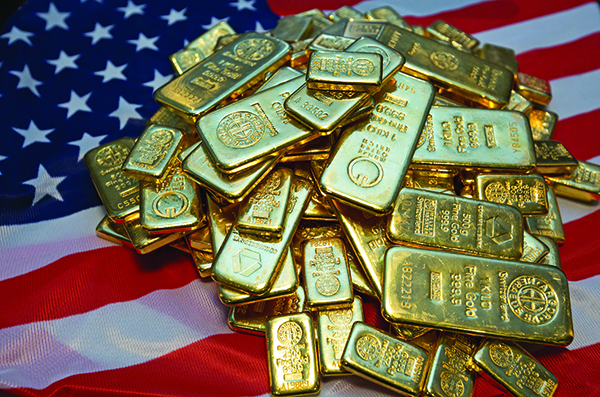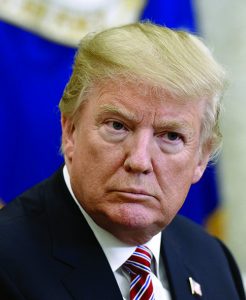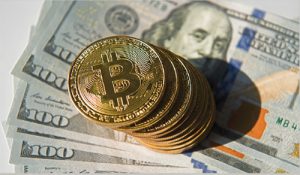
By Joshua McMorrow-Hernandez
History has a way of repeating itself, and if some leaders in the United States and around the world have their way, the gold standard may be heading for an encore. The gold standard, a system that defines the value of currency based on gold, was used in one form or another throughout most of human history until it was officially abolished by the United States and other nations during the earlier decades of the 20th century.

(Photos courtesy Heritage Auctions.)
In the case of the United States, the gold standard suffered a de facto death during the depths of the Great Depression. That is when President Franklin Delano Roosevelt, needing to print more money to support abundant New Deal spending, signed Executive Order 6102 on April 5, 1933, “Forbidding the hoarding of gold coin, gold bullion, and gold certificates within the continental United States.” This ban, which permitted few exceptions (coin collectors were allowed to keep numismatically rare gold coins, and dentists could own up to 100 ounces of gold for use in fillings and other dental applications), had sharp legal teeth to ensure public compliance. Anyone in violation of the order faced a felony charge and incarceration for up to 10 years in federal prison.
The ban was finally lifted 41 years later when President Gerald Ford signed Public Law 93-373, which legalized gold ownership effective Dec. 31, 1974. This move, however, did nothing to restore the gold standard, which by then had been officially dead in the United States for three years.
The final nail in the coffin for the nation’s gold standard was hammered by the hands of President Richard Nixon some three years earlier, on Aug. 15, 1971. In a series of measures collectively referenced by some economists as “the Nixon shock”, President Nixon ended convertibility of the dollar into gold in a grand-scale effort to stabilize the value of the dollar during a period of blooming domestic inflation and changing tides on the international trade scene.
While other nations were also adopting monetary policies favoring fiat (or inconvertible) currencies, the gold window was shuttered in the United States during one of the nation’s darkest socioeconomic chapters. A long-term recessive economy had only begun setting in during the early 1970s, its ripple effects setting off spiraling inflation, massive unemployment, sky-high interest rates, and sluggish income activity that lasted a decade.
The United States has experienced several other recessive economic periods since the “stagflation” era came to a sputtering finish in the early 1980s, including the Great Recession of 2007-2009, when numerous economic markers paralleled those of the Great Depression some seven decades earlier. However, many politicians and economists believe the economy, on both a domestic and international scale, could enjoy more stability, lower inflation, and a greater aura of confidence if governments reinstituted the gold standard.
Others, however, refute the notion that the gold standard could spare America—let alone save the rest of the world—from economic pathos. Would the gold standard even survive in an evolving culture driven by fiat currencies and witnessing the rise of cryptocurrencies such as Bitcoin?
Once upon a time, Federal Reserve notes had 40% backing by federally owned gold. That means the government needed 40 cents in gold for every dollar it printed. In exchange, an individual received $20.67 for every troy ounce of gold turned in. This is also the amount paid to individuals who turned in gold when the yellow metal was recalled in 1933 by Executive Order 6102, which also outlawed gold being used as a medium in contracts.
It was a different world in the first decades of the 20th century. In the simplest terms, fewer dollars were in circulation, there was less public and private debt, and there was enough gold to sufficiently back the federal currency serving in the channels of commerce. But decades of printing fiat currency virtually on demand, mounting runaway debt, and other factors have created a crushing scenario in which even all of the gold ever minted in the world—estimated at around 180,000 metric tons, with an approximate value of $1,350 per ounce—isn’t enough to cover the national debt of the United States, which ticked past the $20 trillion mark in September 2017.
The widening differential between the nation’s growing debt and the monetary value of the world’s limited gold supplies doesn’t necessarily preclude the possibility of backing currency with bullion. Michael Loewy, an associate professor of economics at the University of South Florida, calls to mind an important detail: “During the time that the United States and other nations were truly on the gold standard, roughly 1870 through 1914, commercial banks—the entities that issued circulating notes that were ‘backed’ by gold—did not hold a quantity of gold that provided 100% backing. Indeed, there was no reason for them to do so as the vast majority of notes were kept in circulation rather than were redeemed for specie,” he says. “This would likely be the case were the United States or other nations to return to the gold standard or some other form of commodity-based fixed exchange rate system.”

(Photo by Olivier Douliery-Pool via Getty Images.)
There is no shortage of politicians calling for a 21st-century reprisal of the gold standard. Texas Republican Senator Ted Cruz famously stumped for gold during a debate amid his unsuccessful 2016 presidential bid, when he vowed to stabilize the dollar by adopting a “rules-based monetary supply, ideally tied to gold.” Cruz’s fellow Republican contender Donald Trump, who ultimately became president in January 2017, also prefers tying the dollar to gold. “Bringing back the gold standard would be very hard to do, but, boy, would it be wonderful,” he said in a GQ interview. “We’d have a standard on which to base our money.”
Indeed, it seems “very hard” to revive the gold standard in modern times. French economist Jacques Rueff proposed an international gold standard in the 1960s. Two decades later, Republican politician and American banker Lewis Lehrman, who co-authored The Case for Gold with former Texas Republican congressman Ron Paul, pitched concepts for a modern gold standard. Neither of these proposals came to fruition amid torrents of concern and disagreement as to whether instituting a gold standard would actually help—or conversely, harm—the economy.
“The most common argument that proponents of the gold standard provide is that of ‘controlling inflation’,” remarks Loewy. “Under the gold standard, nations did not typically experience sustained inflation. Rather, prices temporarily rose or fell depending upon the stock of monetary gold,” explains Loewy, who holds a doctorate in economics from the University of Minnesota and has been published in The Journal of Macroeconomics and Oxford Economics Papers, among other publications. “Modern fiat standards allow for sustained increases in the monetary base and so can be susceptible to sustained inflation.”
While the gold standard remains a fringe topic in some American political circles, gold may soon gild the economic policies of nations such as Brazil, Russia, India, China, and South America. Particularly, some leaders in Russia and China are discussing possible plans for incorporating gold into their formal economic policy. “China has already launched a crude oil futures contract,” notes APMEX Director of Numismatics Michael Garofalo, whose company is one of the largest bullion distributors in the United States. “This contract is unusual in that it is denominated in Chinese yuan and it is convertible into physical gold.” The world’s largest importer of oil, China pays for much of its oil with United States dollars. However, China’s new yuan oil futures contract could be a game changer if it gains widespread appeal.
“The Chinese and Russians well understand that, for decades, the United States used the American dollar to control outcomes of economic and industrial policies in different countries,” says Garofalo. “If Russia and China can create a new gold standard or a currency backed by gold, they would do so, in my opinion, to supplant the American dollar as the dominant currency.
“In Asia, Eastern Europe and in much of Africa, gold is vastly more important than any paper fiat currency,” he adds. “Americans, for the most part, have forgotten about gold. They have accumulated so much paper wealth that it is in their best interest to ignore the yellow metal and focus on generating more and more paper American dollars. But other nations, especially China and Russia, see gold as an opportunity for them to suppress American dominance on world markets, weaken the dollar, and cause chaos in Western economies.”
With the Shanghai Gold Exchange (SGE) having established the first yuan-denominated gold benchmark price, Chinese banks (owned by the Chinese government) may supplant London bullion banks in helping set international gold prices. “For a nation as fixated on gold as China is, it makes perfect sense to control the price of gold,” Garofalo remarks. “And that is what I believe the Chinese would like to do.”
In a world in which fiat currencies run the show, what incentives does a nation have for returning to a gold standard, and how would the decision translate in a modern international economy?
“For China the incentives are obvious—end American dollar world domination, give your Asian trading partners a hard currency that they much prefer, control the fix price of gold in the world markets,” answers Garofalo. “For Russia the incentives would be similar—end American Dollar domination and sell more of your natural resource (oil). This would benefit Russia and China in particular,” he notes. “But it would not be an easy thing to do, especially in a free and open society like the United States. It’s likely easier in an authoritarian society like Russia or China where the people have less free will. But there are incentives to doing this, just as there are pitfalls.”
One of the biggest pitfalls? Math. While only 180,000 metric tons (more or less) of gold exists around the world, the gold volume on the London Over The Counter (OTC) market alone totals 1.5 million metric tons. “Obviously, it isn’t physical gold,” notes Garofalo. “And that doesn’t even begin to consider all of the other exchanges where paper investment vehicles, supposedly backed in part or in full by gold, are being traded. Simply put, there is not enough precious metal in the entire world to back up the amount of paper supposedly already backed by gold—they continue to issue these paper securities based on the belief that only a very small number of investors will try to convert their paper securities into physical gold.”
What issues are there with reestablishing a gold standard? “A transition to a gold-based currency might be a great boon to a gold-rich nation, as prices for the physical metal should, in theory, rise, as demand increases,” Garofalo says. “But what about a gold-poor nation? Or a nation, such as the United States, that has large gold reserves, but certainly nowhere near enough gold to back its paper currency? Wouldn’t they resist this and do everything in their power not to allow this to happen?”
There’s yet another problem. “Gold, or any hard asset, tends to limit growth,” Garofalo explains. “What I mean is that if you need the physical asset to back your currency, you are limited in how much growth you can sustain by the amount of physical currency you can acquire and control. Fiat currencies are different in that all you need to do is to get the majority of the people to believe in and accept the currency, based on the full faith and credit of the issuer,” he says. “Then you can print money to your heart’s content. It is much easier to get people to believe in something intangible than it is to acquire enough tangible assets to sustain a high rate of growth.”
And what about maintaining the stability of the dollar? “In the United States, you have the Federal Reserve system to limit the impact of world events on the world’s most powerful fiat currency—the American dollar. By keeping interest rates low, the value of the dollar remains stable, even in volatile times.”
What about the effects gold could have in staving off recessions? “There is a belief among some economists that moving off of the gold standard was a big reason why the United States emerged from the Great Depression as quickly and as strongly as it did,” he says. “The return to the gold standard would be a repudiation of all of the economic policies our nation has put in place since 1933. During the housing crisis of 2008, the U.S. emerged more quickly than many economists had expected or predicted. That may have been due, in large measure, to the fiscal stimulus (Quantitative Easing) provided by the Federal Reserve to jumpstart the economy,” he recalls. “But had we been on a gold standard, the impact of any fiscal stimulus would have been very limited, if it even helped at all. I believe it is highly unlikely that the United States would ever return to even a partial gold standard.”
Finally, there is the issue of digital technology, which was but a dream in the minds of the world’s most inventive visionaries when gold ruled world currencies a century ago. “Technology drives world economies to a much larger degree than physical precious metals do. In fact, due to our ever-changing, technology-driven society we are more likely to see and experience some sort of cryptocurrency becoming prevalent internationally,” he says.

(Photo courtesy Getty Images.)
“Bitcoin’s massive run-up in price, then retrenchment downward again over the last 12 months is evidence that some portions of society are ready to accept a digital version of gold or cash. But the instances where crypto-cash has simply vanished has shown many people that a currency with limited controls and no governmental safeguards offers risks as well as rewards.”
Numismatic historian R.W. Julian be-
lieves the onset of World War II and America’s earnest involvement in the international conflict beginning in 1941—not necessarily the abolishment of the gold standard—played a pivotal role in lifting the United States out of the Great Depression. But he is unsure the gold standard could work in today’s world. “In my view, the gold standard in this age of fiat currency is not going to work,” he notes. “There is not enough gold to maintain a practical standard. Due to the very real threat of counterfeiting, it will never come about that gold coins circulate in the marketplace. If gold is used to balance debts, there would be a demand that gold be valued much higher, which would serve no useful economic purpose.”
And what about China’s overtures? “The attempt by the Chinese to control the price of gold is unlikely to succeed, although they may be able to create artificially high prices on a temporary basis,” Julian says. “[I] think, in the long run, there will be some sort of international currency for balancing debts between nations. The dollar is now widely used for that purpose, but I cannot see it lasting forever.”
Julian is unsure what could replace the dollar on the international monetary scene, but he’s not certain that role belongs to cryptocurrency. “The Bitcoin craze will, I think, soon implode.”
Would coin collectors have anything to gain should China, the United States, or any other nation return to the gold standard? “I doubt that a resurrection of the gold standard in the U.S., which is highly unlikely anyway, would affect the rare coin market,” Julian notes. “It would affect bullion coins of course.”
Julian suggests that China has implications on the rare gold coin market, but not because of its efforts in tying their currency to gold. “The major problem facing the rare coin market is the Chinese counterfeits,” he says, “and that will not go away in the near future.”
Want to receive COINage magazine in your mailbox or inbox? Subscribe today!












